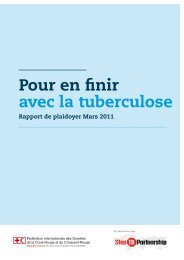Thailand - Stop TB Partnership
Thailand - Stop TB Partnership
Thailand - Stop TB Partnership
Create successful ePaper yourself
Turn your PDF publications into a flip-book with our unique Google optimized e-Paper software.
through appropriate, ongoing support and training for family member observers and village<br />
health volunteers. Some community groups assert that the NTP and <strong>TB</strong> experts should study<br />
the involvement of people living with HIV/AIDS and support groups in the distribution<br />
of antiretroviral drugs as a model for encouraging and involving <strong>TB</strong> patients (and former<br />
patients) in taking responsibility for their own treatment.<br />
<strong>TB</strong>/HIV<br />
After initiating efforts to develop a national <strong>TB</strong>/HIV policy in 1999, the MoPH established<br />
a national <strong>TB</strong>/HIV coordinating body in 2001, which began implementing a strategy to<br />
increase <strong>TB</strong>/HIV collaborative services in 2004. Critics contend that the strategy is still<br />
incomplete; that health workers have not been trained or resourced to implement it; that<br />
“integrating” <strong>TB</strong> and HIV has often meant that the NTP is subsumed within the more<br />
powerful and better resourced National AIDS Control Programme; and that there is an<br />
urgent and unfulfilled need for better coordination between <strong>TB</strong> and HIV/AIDS services at<br />
the field level.<br />
The 2004 strategy stipulates that HIV/AIDS programs should include <strong>TB</strong> counseling<br />
and screening services; <strong>TB</strong> treatment should be provided to all HIV patients with active<br />
<strong>TB</strong>; and efforts should be made to identify latent <strong>TB</strong> cases, particularly among people living<br />
with HIV/AIDS, and to provide prophylactic treatment. 67 The content of the strategy, with<br />
its emphasis on provision of <strong>TB</strong> services to people living with HIV/AIDS, perhaps reflects<br />
the effectiveness of advocacy efforts by HIV/AIDS NGOs. There are almost 900 groups<br />
for people living with HIV/AIDS nationwide, and the network has been vocal, active, and<br />
successful in obtaining nearly universal access to ARVs for people with HIV. 68 This strategy<br />
should be developed further to facilitate early detection of HIV, free HIV testing, and<br />
routine CD4-count testing among <strong>TB</strong> patients as well. Recent population-based surveillance<br />
indicates that 90 percent of <strong>TB</strong> patients have compromised CD4 counts (below 200). The<br />
death rate for HIV-infected <strong>TB</strong> patients is 20–30 percent, and ARV therapy provided during<br />
<strong>TB</strong> treatment can reduce the relative risk of death by 90 percent. 69<br />
As implementation of the national <strong>TB</strong>/HIV strategy began relatively recently, reliable<br />
data on its results and impact are not yet available. However, a number of challenges<br />
have become immediately apparent. Health workers are not well informed about or trained<br />
on how to put the policy into operation. According to one <strong>TB</strong> doctor, <strong>TB</strong> clinical workers have<br />
not been trained on how to conduct HIV counseling and testing, while HIV clinical workers<br />
have little experience with <strong>TB</strong>. 70 Particularly in the northern region, health officials contend<br />
that the lack of integrated services and the difficulties in diagnosing <strong>TB</strong> among people living<br />
with HIV/AIDS have led to a drop in treatment success rates and rising mortality rates<br />
PUBLIC HEALTH WATCH MONITORING REPORTS 49


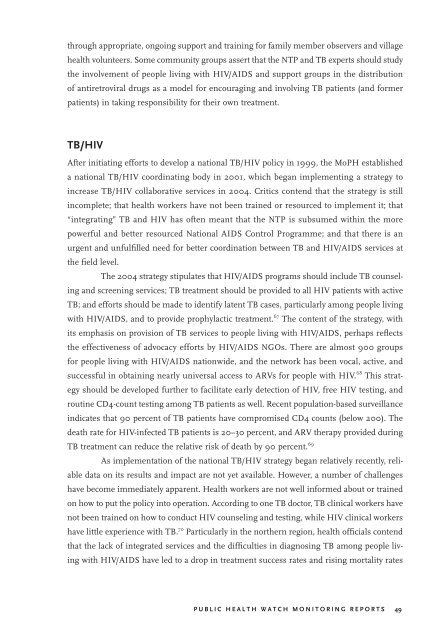
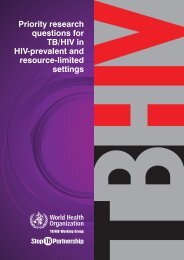
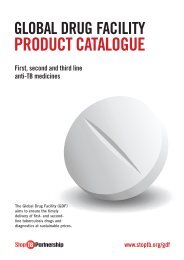
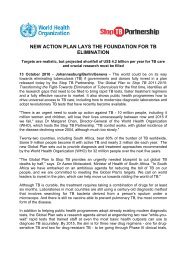
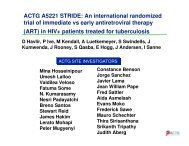
![Global Drug Facility Annual Report 2011 [.pdf] - Stop TB Partnership](https://img.yumpu.com/26788745/1/184x260/global-drug-facility-annual-report-2011-pdf-stop-tb-partnership.jpg?quality=85)

![Concept note on national stop TB partnership [.pdf]](https://img.yumpu.com/26788741/1/184x260/concept-note-on-national-stop-tb-partnership-pdf.jpg?quality=85)
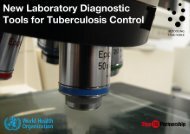

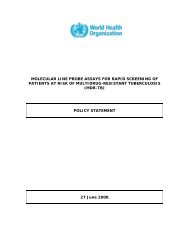
![2005 and Challenges for 2006 - 2015 [.pdf] - Stop TB Partnership](https://img.yumpu.com/26788674/1/190x245/2005-and-challenges-for-2006-2015-pdf-stop-tb-partnership.jpg?quality=85)
![Brochure (French) [.pdf] - Stop TB Partnership](https://img.yumpu.com/17234792/1/190x91/brochure-french-pdf-stop-tb-partnership.jpg?quality=85)

